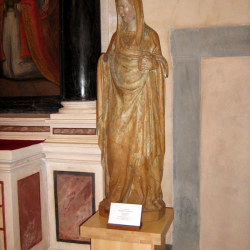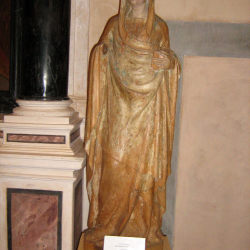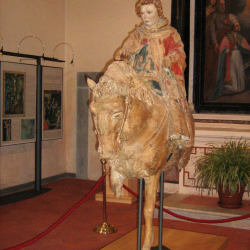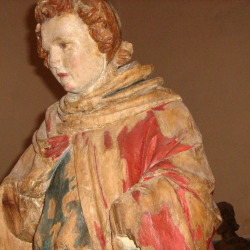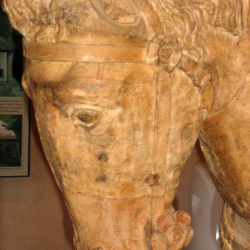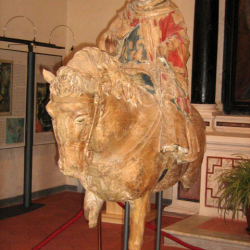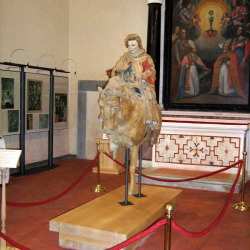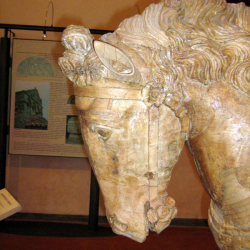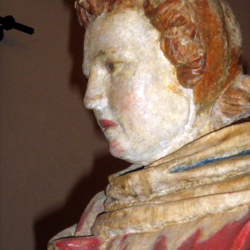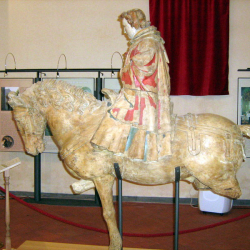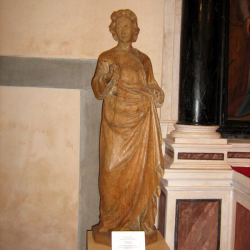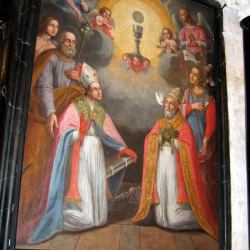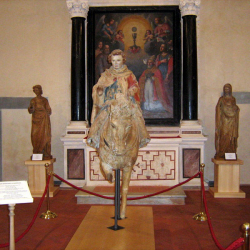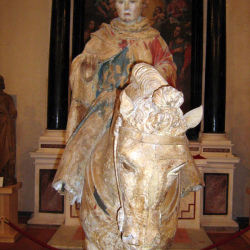Sala Espositiva Parrocchia di San Cassiano di ControneSAN CASSIANO DI CONTRONE – BAGNI DI LUCCA |
| Oratorio di San Cassiano di Controne, 55027 Bagni di Lucca
www.museivalledelserchio.it www.sancassianodicontrone.com/museo |
Contatti:0583 89275 – 346 6909711 |
S. Cassiano è uno degli edifici ecclesiastici più interessanti della lucchesia. Si tratta di una delle poche chiese già esistenti in età longobarda che si è conservata fino ai nostri giorni senza diventare pieve. Questo bell´edificio – databile nelle sue forme attuali ai secoli XI-XII- costituisce uno degli esempi di architettura romanica meglio conservati nel territorio rurale di Lucca, oltre a presentare uno dei più ricchi apparati decorativi romanici di tutta la diocesi di Lucca.
In una sala attigua alla chiesa è stato realizzata una sala museale nella quale si distinguono due opere:
SAN MARTINO A CAVALLO (Jacopo Della Quercia)
Rivenuta casualmente nel 1909 in una legnaia della Chiesa di S. Cassiano di Controne, l´opera costituisce un esempio della diffusa pratica di relegare nelle chiese del contado gli arredi in disuso della chiese cittadine: nel nostro caso l’opera sembra provenire dalla Cattedrale di Lucca San Martino.
Recuperato dopo un recente restauro, che ha restituito i volumi, il modellato e la policromia originari, il Santo Cavaliere segna un vertice nella scultura a Lucca all´inizio del Quattrocento e anche nella produzione giovanile di Jacopo della Quercia, a cui l´opera è stata attribuita. Su un cavallo, privo degli arti posteriori, dell´anteriore destro e della coda , è rappresentato un cavaliere dai tratti giovanili con capigliatura bionda e arricciata trattenuta da una cuffia; un ampio mantello con cappuccio avvolge la figura mancante delle braccia, un tempo nell´atto di recidere con la spada un lembo di stoffa per donarlo ad un mendicante.
MADONNA ANNUNCIATA/ANGELO ANNUNCIANTE (Maestro dell’Annunciazione di San Cassiano)
Il gruppo, databile alla prima metà del Trecento, è stato avvicinato al Crocifisso del Museo dell´Opera del Duomo di Firenze, all´opera dunque di un maestro toscano esordiente sull´esempio di Giovanni Pisano e strettamente legato alle conquiste giottesche. Entrambe le statue di S. Cassiano sono infatti direttamente confrontabili con immagini di Giotto. Si distinguono per la loro qualità ed eleganza sia nei gesti che nelle forme. Particolare eleganza si riscontra nella armoniosità delle vesti e nell’eleganza del trattamento dei capelli
In una sala attigua alla chiesa è stato realizzata una sala museale nella quale si distinguono due opere:
SAN MARTINO A CAVALLO (Jacopo Della Quercia)
Rivenuta casualmente nel 1909 in una legnaia della Chiesa di S. Cassiano di Controne, l´opera costituisce un esempio della diffusa pratica di relegare nelle chiese del contado gli arredi in disuso della chiese cittadine: nel nostro caso l’opera sembra provenire dalla Cattedrale di Lucca San Martino.
Recuperato dopo un recente restauro, che ha restituito i volumi, il modellato e la policromia originari, il Santo Cavaliere segna un vertice nella scultura a Lucca all´inizio del Quattrocento e anche nella produzione giovanile di Jacopo della Quercia, a cui l´opera è stata attribuita. Su un cavallo, privo degli arti posteriori, dell´anteriore destro e della coda , è rappresentato un cavaliere dai tratti giovanili con capigliatura bionda e arricciata trattenuta da una cuffia; un ampio mantello con cappuccio avvolge la figura mancante delle braccia, un tempo nell´atto di recidere con la spada un lembo di stoffa per donarlo ad un mendicante.
MADONNA ANNUNCIATA/ANGELO ANNUNCIANTE (Maestro dell’Annunciazione di San Cassiano)
Il gruppo, databile alla prima metà del Trecento, è stato avvicinato al Crocifisso del Museo dell´Opera del Duomo di Firenze, all´opera dunque di un maestro toscano esordiente sull´esempio di Giovanni Pisano e strettamente legato alle conquiste giottesche. Entrambe le statue di S. Cassiano sono infatti direttamente confrontabili con immagini di Giotto. Si distinguono per la loro qualità ed eleganza sia nei gesti che nelle forme. Particolare eleganza si riscontra nella armoniosità delle vesti e nell’eleganza del trattamento dei capelli
S. Cassiano is one of the most interesting ecclesiastical buildings in Lucchesia. It is one of the very few churches present in the Longobard Age that has survived to the present day without becoming a Parish. This stunning building – belonging to the 11th-12th century, represents one of the best preserved examples of Romanesque architecture in the rural area of Lucca, over and above boasting one of the richest Romanesque decorative set ups in all the Diocese of Lucca. In a room adjoining the church a museum hall has been set up, here two works of art stand out the most:
SAN MARTINO A CAVALLO – St Martin on horseback (Jacopo Della Quercia)
Found by accident in 1909 in a woodshed of the Church of S. Cassiano di Controne, this work of art represents an example of the widespread practice of storing (in rural churches) the furnishings of town churches, no longer in use. In this case the work of art seems to have belonged to the cathedral San Martino in Lucca. Retrieved after a recent restoration, which has regained the original volumes, shape and polychromy, the knight Saint represents a turning-point in sculpture in Lucca at the beginning of the 400 and also in the early production of Jacopo della Quercia, to whom the work is attributed. A young knight with blonde, curly hair tied in a ponytail is seated on a horse with no hind legs, front legs and tail; a wide cloak with hood is wrapped around the missing arms, at one time in the act of cutting off a piece of cloth to give it to a beggar.
MADONNA ANNUNCIATA/ANGELO ANNUNCIANTE (Artist of the Annunciation of San Cassiano)
The set, dating back to the first half of the 12th century is fairly close to the crucifix of the Museo dell’Opera of the Cathedral of Florence. The work of a novice Tuscan artist following the example of Giovanni Pisano and very close to Giottesque achievements. Both the statues of S. Cassiano can be easily compared to Giotto’s works. They not only standout for their quality and grace of their actions but also for their form. This astonishing grace can be admired in the harmony of the clothing and in the hair styles.
SAN MARTINO A CAVALLO – St Martin on horseback (Jacopo Della Quercia)
Found by accident in 1909 in a woodshed of the Church of S. Cassiano di Controne, this work of art represents an example of the widespread practice of storing (in rural churches) the furnishings of town churches, no longer in use. In this case the work of art seems to have belonged to the cathedral San Martino in Lucca. Retrieved after a recent restoration, which has regained the original volumes, shape and polychromy, the knight Saint represents a turning-point in sculpture in Lucca at the beginning of the 400 and also in the early production of Jacopo della Quercia, to whom the work is attributed. A young knight with blonde, curly hair tied in a ponytail is seated on a horse with no hind legs, front legs and tail; a wide cloak with hood is wrapped around the missing arms, at one time in the act of cutting off a piece of cloth to give it to a beggar.
MADONNA ANNUNCIATA/ANGELO ANNUNCIANTE (Artist of the Annunciation of San Cassiano)
The set, dating back to the first half of the 12th century is fairly close to the crucifix of the Museo dell’Opera of the Cathedral of Florence. The work of a novice Tuscan artist following the example of Giovanni Pisano and very close to Giottesque achievements. Both the statues of S. Cassiano can be easily compared to Giotto’s works. They not only standout for their quality and grace of their actions but also for their form. This astonishing grace can be admired in the harmony of the clothing and in the hair styles.








